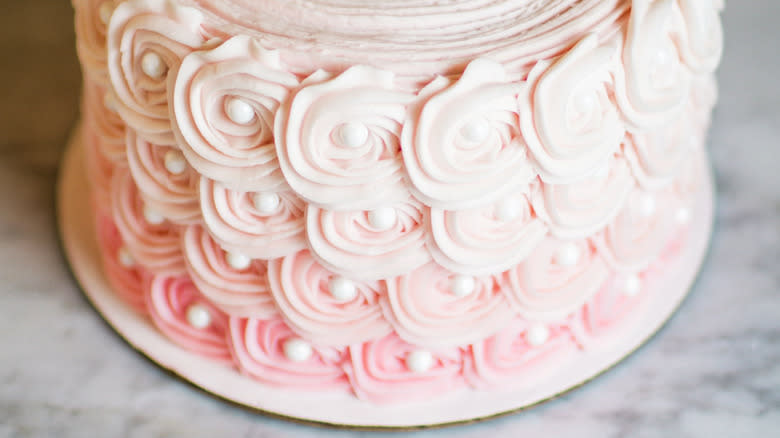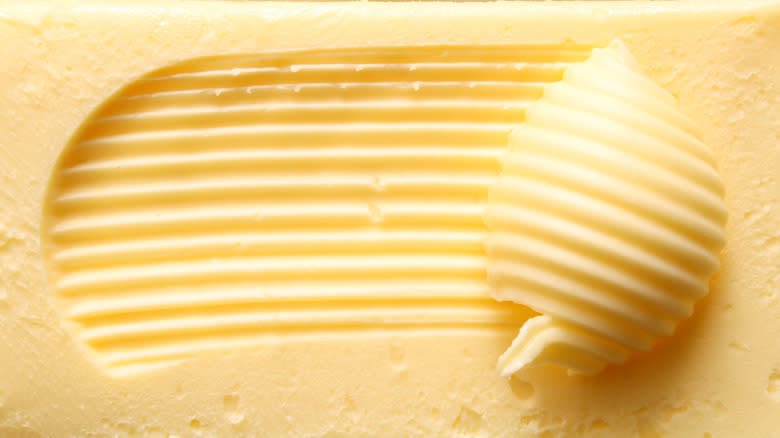Fats You Should And Should Not Use When Baking, According To Elizabeth Chambers

There are numerous components that are important for the production of a top-tier cake. Sugar, flour, eggs, a leavening agent, salt -- each has its place, and every one is vital to cake making. So is another element of the cooking process: fats. There's no shortage of options when it comes to picking a fat for baking, and because there are certainly plenty of proven choices, they'll all produce good cakes, right?
According to Elizabeth Chambers, CEO and founder of BIRD Bakery, the answer is an emphatic no. Chambers told Daily Meal that high-quality butter is her go-to pick -- even though some recipes might call for a neutral oil. "Fat is integral to the cake baking process," she says. But she was also quick to specify that, "The type of fat is most definitely dependent on the batter." With that in mind, there are a couple of types of fat she recommends you avoid, as "shortening and margarine are both on my personal no-fly list."
Read more: Cake Hacks Every Baker Will Wish They Knew Sooner
Butter And Neutral Oil Each Have Their Uses

As far as which fats are better to use in cakes, Elizabeth Chambers has some suggestions: Good butter, or, in specific recipes, a good oil. "High-quality butter is my go-to for most cake batters," she says, although she said she will make an exception and use vegetable oil in certain cake recipes, such as carrot and red velvet. "I'm not a fan of vegetable or canola oils in general, but you can't argue with the texture and taste it creates for certain recipes," she says.
The level of the butter is crucial here, as the most important part of how to choose butter when baking is to not skimp on quality. The higher fat-to-water ratio of a good butter will produce a better bake by providing both a more pronounced buttery flavor and a richer consistency. Though it isn't a universal truism, many Irish and other European butters do tend to have a higher ratio of fat to water than common American butters, making them excellent choices for baking.
The reason you might want neutral oils sometimes, though, is that because they stay liquid at room temperature, they'll impart a tender, moist bite that even butter can't match. In addition to the examples Chambers lists, chiffon and chocolate cake both benefit from the additional moistness provided by neutral oils in place of butter.
Shortening And Margarine Are The Fats To Stay Away From

Elizabeth Chambers (pictured above) doesn't recommend using shortening and margarine, however. Technically, shortening is any fat that remains solid at room temperature, so butter and lard, as well as vegetable shortening. In practice, though, the term is most often colloquially used the way Chambers does: To describe vegetable shortening such as Crisco, which provides a solid-at-room-temperature fat that doesn't impart any flavor. In general, there are things to consider before baking with shortening instead of butter, but according to Chambers, using shortening in any cake is a bad idea. She calls it, "The one fat that is an absolute no for me ... I will not use it, regardless of what the recipe calls for." It makes sense: Shortening's 100% fat content is great for pie crusts, as it helps them hold shape, but it doesn't provide the richness other fats would in a cake. Fortunately, there are lots of substitutes for shortening in baking.
Likewise, Chambers isn't a fan of margarine, a mixture of plant or animal fats with oil or milk. She says, "I prefer whole ingredients as often as possible, and [I] don't believe that shortening and margarine provide any benefit in terms of taste or texture." This, too, makes sense. In any recipe that calls for softened butter, like cakes, margarine tends to keep your bakes from being as soft as you'd like, as it has a higher ratio of water to fat than butter.
Read the original article on The Daily Meal.

